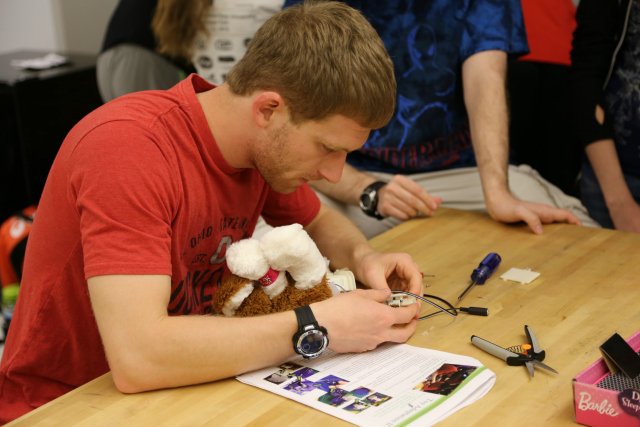Betsy Piland, December 3, 2016
Observe a preschool classroom for just a few minutes and it?s clear that children learn through play. They are busy using their imaginations, dreaming big, furrowing their brows over a puzzle, and, yes, sometimes taking toys apart to see what?s inside. It?s not so different for much older students, like those in The Ohio State University's Toy Adaptation Program (TAP).
TAP?s mission is twofold: to offer hands-on education to OSU?s engineering students while providing modified electronic toys to children who fall within a spectrum of different abilities. This combination of experiential learning while tackling a social need has been a win-win for both the students and young children.
?Many students comment that this experience embodies the reason they went into engineering,? says OSU Department of Engineering Education assistant professor Rachel Kajfez said. ?They want to help people. Participating in a workshop, whether it be as a formal lab in a class or a volunteer opportunity, shows students they can make a difference.?
The children who receive these toys vary in their specific needs so each toy or modification is a new challenge.
?We adapt toys by reverse engineering them,? says Kajfez. ?Specifically, we open up the toys and examine the circuitry. We then determine a location to add a simple audio jack. Once the jack is installed, a child can operate the toy using a variety of switches that meet their unique needs.?

Kajfez says the program helps students make a real-world connection to their academic study and has a lasting impression on them.
TAP founder and program manager Elizabeth Riter explains that before each workshop, they share stories of those who have benefited from the program, sometimes with guest speakers or video messages.
Currently, TAP donates most of the adapted toys to toy lending libraries or directly to families at no cost. They collaborate with a local organization, Katelyn?s Krusade, as well as the OSU Toy and Technology Library at the Nisonger Center. Families typically find out about the program through one of these groups or at Nationwide Children?s Hospital.
While TAP is just a few years old, Kajfez and Riter continue to assess the impact these experiences have on their engineering students–it?s not yet known if there will be a long-term student impact–and they?ve started to assess the broader impact on families and the community.
Kajfez and Riter both hope that participating in a TAP workshop can open students? eyes to the service engineers can provide. ?We would love to hear that TAP inspired them to pursue a career in this area of work,? Kajfez said. The number of workshops, activities and modified toys have all steadily increased in number since the first workshop in April 2013. ?This year alone, we have adapted approximately 400 toys and have had over 800 students participate in the program,? Kajfez said.
Planning TAP workshops are no easy task, explained Kajfez. There are a lot of moving parts, both literally and figuratively. ?That said, any challenge is worth it when you see the look on a child?s face when they receive an adapted toy, or observe a family learn how to adapt toys for themselves. Those moments are priceless and drive us to continue this work.?
?OSU has been extremely supportive of the program,? Riter said. Beyond financial support, which TAP has received in the form of two grants from the university, Riter said that the College of Engineering and the Department of Engineering Education have allowed TAP to integrate its work into courses, programs, and other co-curricular activities. ?Without their support, this work would not be possible.?
To donate or learn more about OSU?s Toy Adaptation Program, visit https://u.osu.edu/osutap/.







